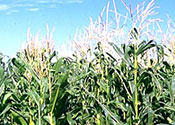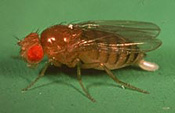The amount of gene flow that goes on between populations varies a lot depending on the type of organism.
As you would expect, populations of relatively sedentary organisms are more isolated from one another than populations of very mobile organisms.

Lower rate of gene flow
Corn, which is wind-pollinated, may be unlikely to fertilize individuals more than 50 feet away.

Higher rate of gene flow
However, other organisms are able to distribute their genes much further. For example, fruit flies released in Death Valley were recaptured almost 15 kilometers away from the site of release.
Gene flow has several important effects on evolution:
- Within a population
It can introduce or reintroduce gene versions to a population, increasing the genetic variation of that population. - Across populations
By moving genetic material around, it can make distant populations genetically similar to one another, hence reducing the chance of speciation. The less gene flow between two populations, the more likely that two populations will evolve into two species.
